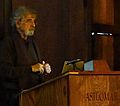Humberto Maturana facts for kids
Quick facts for kids
Humberto Maturana
|
|
|---|---|

Maturana in 2013
|
|
| Born | September 14, 1928 |
| Died | May 6, 2021 (aged 92) Santiago, Chile
|
| Nationality | Chilean |
| Alma mater | University of Chile; University College London; Harvard University |
| Awards | National Prize for Natural Sciences |
| Scientific career | |
| Institutions | University of Chile; Instituto de Formación Matríztica |
Humberto Maturana (September 14, 1928 – May 6, 2021) was an important Chilean biologist and philosopher. He was born in Santiago, Chile. Maturana was known for his unique ideas about how living things work and how we understand the world around us.
He worked with another scientist, Francisco Varela, to create the idea of autopoiesis. This word helps explain what makes living things special. His ideas have been very important in many areas, especially in understanding how different parts of a system work together.
Contents
Who Was Humberto Maturana?
Humberto Maturana was a scientist who studied how living systems are organized. He was part of a group of thinkers called "systems scientists" and "cyberneticians." These scientists look at how different parts of a system connect and influence each other. Think of a bicycle: it's a system where all the parts must work together for it to move.
Maturana's main interest was the "biology of cognition." This means he wanted to understand how living beings, like us, create our own understanding of the world. He believed that our brains and bodies don't just take in information. Instead, they actively build our reality based on our experiences.
Understanding Autopoiesis
What Does Autopoiesis Mean?
One of Maturana's most famous ideas is autopoiesis. This word comes from Greek and means "self-making" or "self-producing." He used it to describe what makes a living system different from a non-living one.
Imagine a living cell. It's constantly making and replacing its own parts. It keeps itself alive and organized from the inside. This is autopoiesis. A rock, on the other hand, doesn't do this. It doesn't actively maintain its own structure.
How Autopoiesis Works
For Maturana, a system is autopoietic if it continuously creates its own parts and processes. These parts and processes then work together to keep the system going. This means living things are always busy keeping themselves alive and separate from their surroundings.
This idea helps us understand that living beings are not just machines. They are self-organizing systems that actively create and maintain their own existence.
How We Know: Biology of Cognition
Our Active Role in Knowing
Maturana's work on the "biology of cognition" suggests that we don't just passively receive information from the world. Instead, our brains and bodies actively build our understanding. Think of it like this: your brain isn't just a camera recording what's out there. It's more like an artist creating a painting based on what it senses.
This means that what we "know" about the world is shaped by our own unique experiences and how our nervous system works. Everyone's understanding can be a little different because we all have unique experiences.
How We Interact with the World
Maturana believed that our actions and interactions are key to how we learn and understand. We don't just observe the world; we are always interacting with it. These interactions change us, and we, in turn, change our environment. This constant dance of interaction helps us build our knowledge.
For example, when you learn to ride a bike, you don't just read about it. You try it, you fall, you adjust, and through these actions, your body and brain learn how to balance and steer.
His Life and Legacy
Humberto Maturana was a professor at the University of Chile. His ideas have influenced many fields, including biology, psychology, and even how people think about communication and education. He helped us see living things and our own minds in a new way.
Maturana passed away on May 6, 2021, in Santiago, Chile, at the age of 92. He left behind a legacy of deep thinking about life, knowledge, and how we interact with the world.
Images for kids
See also
In Spanish: Humberto Maturana para niños




